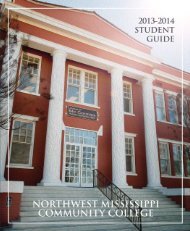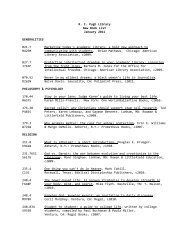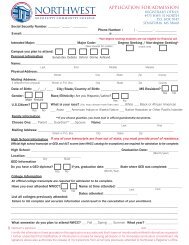Coping with Seven Disruptive Personality Types in the Classroom
Coping with Seven Disruptive Personality Types in the Classroom
Coping with Seven Disruptive Personality Types in the Classroom
Create successful ePaper yourself
Turn your PDF publications into a flip-book with our unique Google optimized e-Paper software.
kThe Explosive StudentCharacteristicsThe student <strong>with</strong> an explosive personality style is easy to recognize <strong>in</strong> <strong>the</strong> classroom. That isbecause <strong>the</strong> explosive student is <strong>in</strong>cl<strong>in</strong>ed to be volatile <strong>in</strong> ways that draw everyone’sattention. Explosive students will shout, use profanity <strong>with</strong> abandon, engage <strong>in</strong> bully<strong>in</strong>gbehavior, and sometimes make veiled or explicit verbal or physical threats. Explosive collegestudents have also been known to pick fights and <strong>in</strong>terrupt lectures <strong>with</strong> loud and abusiveremarks. Sometimes <strong>the</strong>y will use office meet<strong>in</strong>gs <strong>with</strong> <strong>in</strong>structors to <strong>in</strong>timidate and harass<strong>the</strong>m.For a wide range of reasons, some explosive students display explosive behavior only<strong>in</strong>termittently and ra<strong>the</strong>r harmlessly. O<strong>the</strong>rs, however, may be on a rampage from <strong>the</strong> day<strong>the</strong>y arrive on campus, and <strong>the</strong>ir explosive behavior may get out of control repeatedly.Therefore, <strong>the</strong>se students are apt to pose a persistent threat to o<strong>the</strong>r students and to <strong>the</strong>ir<strong>in</strong>structors.It can be a big shock to a professor to experience this sort of outburst <strong>in</strong> <strong>the</strong> classroom. It isnot <strong>the</strong> sort of th<strong>in</strong>g one ord<strong>in</strong>arily expects to experience while teach<strong>in</strong>g, and <strong>the</strong>refore it canbe very difficult and confus<strong>in</strong>g to know what to do, especially if <strong>the</strong>re have been no warn<strong>in</strong>gsigns of impend<strong>in</strong>g trouble before <strong>the</strong> offend<strong>in</strong>g outburst.How to Respond• Safety firstWhen <strong>in</strong>structors are faced <strong>with</strong> a student who is severely out of control <strong>with</strong> rage, ei<strong>the</strong>r <strong>in</strong>an office or <strong>in</strong> a classroom, <strong>the</strong>ir first concern should be <strong>the</strong> safety of <strong>the</strong>ir students and<strong>the</strong>mselves.Consider <strong>the</strong> frighten<strong>in</strong>g situation of a student who, <strong>in</strong> a rage, threatened to kill. When thispossible scenario was posed, one <strong>in</strong>structor stated that she would most likely respond byescort<strong>in</strong>g <strong>the</strong> student to <strong>the</strong> campus psychological service.Unfortunately, this is not a good idea. The reasons for not carry<strong>in</strong>g out such a measureshould be fairly obvious. The student may <strong>in</strong> fact be an imm<strong>in</strong>ent threat to o<strong>the</strong>rs and should<strong>the</strong>refore not be chaperoned anywhere by a defenseless <strong>in</strong>structor.7




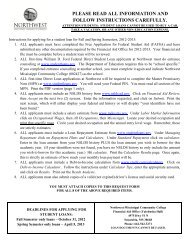




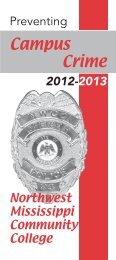

![Pro-Dental Hygiene [Major Code T34] - Northwest Mississippi ...](https://img.yumpu.com/35524032/1/190x149/pro-dental-hygiene-major-code-t34-northwest-mississippi-.jpg?quality=85)

